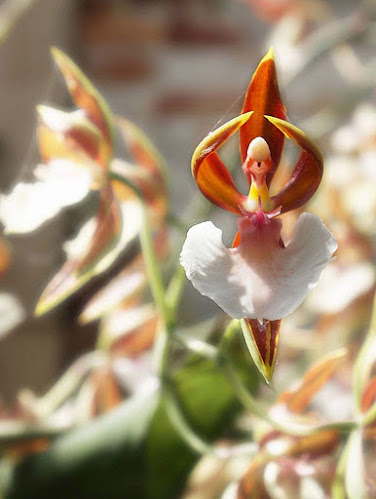IN THE NAME OF ALLAH, THE MOST
GRACIOUS
AND THE MOST MERCIFUL...!!
*************************
BIODIVERSITY IS
THE
TOTALLY OF ALL
INHERITED
VARIATION IN
THE LIFE
FORMS OF EARTH,
OF WHICH WE ARE
ONE SPECIES.
WE STUDY & SAVE
IT TO OUR
GREAT BENEFIT.
WE IGNORE
AND
DEGRADE
IT TO OUR
GREAT PERIL...!!
*************************
ENDANGERED FLORA & FAUNA
FLORA - The plants of a particular region or period, listed by species and considered as a whole. a work systematically describing such plants. plants, as distinguished from fauna. the aggregate of bacteria, fungi, and other microorganisms normally occurring on or in the bodies of humans and other animals: intestinal flora.
FAUNA - Fauna is all of the animal life present in a particular region or time. The corresponding term for plants is flora. Flora, fauna and other forms of life such as fungi are collectively referred to as biota.
✅ENDANGERED FLORA
☆Matchstick Banksia
Banksia cuneata, commonly known as matchstick banksia or Quairading banksia, is an endangered species of flowering plant in the family Proteaceae. Endemic to southwest Western Australia, it belongs to Banksia subg.
☆Grandidier's Baobab
Adansonia grandidieri, sometimes known as Grandidier's baobab, is the biggest and most famous of Madagascar's six species of baobabs. This imposing and unusual tree is endemic to the island of Madagascar, where it is an endangered species threatened by the encroachment of agricultural land.
☆Nematoleis Wilsonii
Nematolepis wilsonii is an endangered shrub or small tree species which is endemic to Victoria in Australia. It may grow up to 10 metres tall and has mottled bark. The shiny green leaves are 30 to 80 mm long and 5 to 15 mm wide, and have silvery scales underneath.
☆Grevillea Flexuosa
Grevillea flexuosa, commonly known as zigzag grevillea or tangled grevillea, is an endangered shrub endemic to Western Australia.
Syzygium smithii is a summer-flowering, winter-fruiting evergreen tree, belonging to the myrtle family Myrtaceae. It shares the common name "lilly pilly" with several other plants. In New Zealand, it is commonly known as 'monkey apple'
Phebalium daviesii, commonly known as St Helens wax flower or Davies' wax flower, is a species of shrub that is endemic to a restricted area in Tasmania.
Lomatia tasmanica, commonly known as King's lomatia, is a shrub of the family Proteaceae native to Tasmania. Growing up to 8 metres tall, the plant has shiny green pinnate leaves and bears red flowers in the summer, but yields neither fruit nor seeds.
Darwinia meeboldii, the Cranbrook bell, is a shrub which is endemic to the south-west of Western Australia. It has an erect and straggly habit, growing to between 0.5 and 3 metres high. The bracts around the flowers form a pendent "bell" which is usually white with red tips.
Daviesia euphorbioides. Daviesia euphorbioides Fabaceae. 'Wongan Cactus' Short multi-branched shrub, 500 - 800 mm in height and 500 mm - 1 m in diameter. Rigid, mostly ascending leafless stems with short sharp thorns.
☆Wollemi Pine
The Wollemi Pine is one of the world's oldest and rarest plants dating back to the time of the dinosaurs. With less than 100 adult trees known to exist in the wild, the Wollemi Pine is now the focus of extensive research to safeguard its survival. Wollemi pine, (Wollemia nobilis), rare evergreen tree, a member of the conifer family Araucariaceae and the only member of its genus. Wollemi pine was found in 1994 growing in a remote canyon in Wollemi National Park, about 200 km (120 miles) northwest of Sydney.
Pimelea spinescens or spiny riceflower is a critically endangered shrub native to central and western Victoria, Australia. P. spinescens grows to up to 30 cm tall and is found in lowland grassland. The plant is dioecious and unlike others of its genus is non-toxic.
Hibiscus insularis, the Phillip Island hibiscus, is a species of flowering plant in the mallow family Malvaceae, that is endemic to Phillip Island, a small island to the south of Norfolk Island, Australia.
Drakaea is a genus of 10 species in the plant family Orchidaceae commonly known as hammer orchids. All ten species only occur in the south-west of Western Australia. Hammer orchids are characterised by an insectoid labellum that is attached to a narrow, hinged stem, which holds it aloft.
Caladenia dorrienii, commonly known as the Cossack spider orchid is a species of orchid endemic to the south west of Western Australia. It has a single hairy leaf and one, two or sometimes three small creamy-white flowers, usually with the lateral seals and petals curving around the ovary and crossing each other. It is a rare orchid, only found in the extreme south-east of the state.
☆Basil Mountain
One of the best varieties for ornamental value, this plant displays large, deeply colored flowers all summer. The purple-hued, dark green leaves are great for adding flavor to pesto, sauces, salads and meat dishes. Less cold-sensitive than other basils.
☆Shrub
A shrub or bush is a small- to medium-sized perennial woody plant. Unlike herbaceous plants, shrubs have persistent woody stems above the ground. Shrub can be deciduous or evergreen. They are distinguished from trees by their multiple stems and shorter height, less than 6 m-10 m tall.
Colchicum autumnale, commonly known as autumn crocus, meadow saffron or naked ladies, is a toxic autumn-blooming flowering plant that resembles the true crocuses, but is a member of the plant family Colchicaceae, unlike the true crocuses which belong to the family Iridaceae.
Rafflesia is a genus of parasitic flowering plants in the family Rafflesiaceae. It contains approximately 28 species, all found in Southeast Asia, mainly in Indonesia, Malaysia, Thailand and the Philippines.
Papaver somniferum, commonly known as the opium poppy or breadseed poppy, is a species ... Australia (Tasmania), Turkey and India are the major producers of poppy for medicinal purposes and poppy-based drugs, such as morphine or codeine. ... The name Czech blue poppy refers to blue poppy seeds used for food
☆Amoephophallus
Amorphophallus is a large genus of some 200 tropical and subtropical tuberous herbaceous plants from the Arum family, native to Asia, Africa, Australia and various oceanic islands. A few species are edible as "famine foods" after careful preparation to remove irritating chemicals.
☆Sarracenia
Sarracenia is a genus comprising 8 to 11 species of North American pitcher plants, commonly called trumpet pitchers. The genus belongs to the family Sarraceniaceae, which also contain the closely allied genera Darlingtonia and Heliamphora.
☆Durabaculu Nindii
Dendrobium nindii, commonly known as the blue antler orchid, is an epiphytic or lithophytic orchid in the family Orchidaceae. It has erect, cylindrical, leafy pseudobulbs with leathery, dark green leaves and up to twenty mauve or violet flowers with darker veins on the labellum. This antler orchid occurs in tropical North Queensland and New Guinea.
Derbyshire is a county in the East Midlands of England. A substantial portion of the Peak District National Park lies within Derbyshire, containing the southern extremity of the Pennine range of hills which extend into the north of the county.
This plant is called the silver tree because on a sunny day it glistens with a stunning silvery sheen. To reduce water loss the hairs flatten and not only reflect away a lot of heat and light but also reduce the level of transpiration to prevent the leaves from drying out.
Billbergia alfonsi-joannis is a species in the genus Billbergia. This species is endemic to southeastern Brazil, from Espírito Santo to Santa Catarina.
Cipocereus bradei is a species of cactus. It is endemic to the state of Minas Gerais in Brazil. It is threatened by habitat loss.
Aeonium saundersii forms a short compact grower form that offsets readily, with highly succulent hairy leaves that developed a red tinge in strong light.
Yellow hibiscus (Hibiscus brackenridgei) is a flowering shrub that grows on all the Hawaiian islands except Ni'ihau and Kaho'olawe. All three subspecies of the yellow hibiscus are listed as endangered species. Even in Hawaii, the plant is rare.
☆Medeola Virginiana
Medeola virginiana, Indian cucumber-root, is an eastern North American plant species in the lily family, Liliaceae. It is the only currently recognized plant species in the genus Medeola. Indian cucumber-root grows in the understory of forests. The plant bears edible rhizomes that have a mild cucumber-like flavor.
Aloidendron pillansii, formerly Aloe pillansii, the giant quiver tree or bastard quiver tree, is a large, branching species of succulent plant indigenous to southern Africa. It is regarded as critically endangered.
☆Gum Nuts
Gumnut can refer to: The hard woody fruit of trees of the genus Eucalyptus. Snugglepot and Cuddlepie, the gumnut babies of author May Gibbs.
✅ENDANGERED FAUNA
FAUNA - Fauna is all of the animal life present in a particular region or time. The corresponding term for plants is flora. Flora, fauna and other forms of life such as fungi are collectively referred to as biota
☆Amur Leoard
The Amur leopard is a leopard subspecies native to the Primorye region of southeastern Russia and northern China. It is listed as Critically Endangered on the IUCN Red List. In 2007, only 19–26 wild leopards were estimated to survive in southeastern Russia and northeastern China.
☆Black Rhino
Black rhinos are the smaller of the two African rhino species. The most notable difference between white and black rhinos are their hooked upper lip. This distinguishes them from the white rhino, which has a square lip.
☆Borean Orangutan
The Bornean orangutan is a species of orangutan native to the island of Borneo. Together with the Sumatran orangutan and Tapanuli orangutan, it belongs to the only genus of great apes native to Asia.
☆Cross river Gorilla
☆Eastern lowland gorilla
The hawksbill sea turtle is a Critically Endangered sea turtle belonging to the family Cheloniidae. It is the only extant species in the genus Eretmochelys. The species has a worldwide distribution, with Atlantic and Indo-Pacific subspecies—E. i. imbricata and E. i. bissa, respectively.
☆Javan Rhino
☆Orangutan
The orangutans are three extant species of great apes native to Indonesia and Malaysia. Orangutans are found in the rainforests of Borneo and Sumatra, but during the Pleistocene they ranged throughout Southeast Asia and South China.
☆Saola
The Sumatran elephant is one of three recognized subspecies of the Asian elephant, and native to the Indonesian island of Sumatra.
☆Sumatran Orangutan
The Sumatran rhinoceros, also known as the hairy rhinoceros or Asian two-horned rhinoceros, is a rare member of the family Rhinocerotidae and one of five extant species of rhinoceros. It is the only extant species of the genus Dicerorhinus.
☆Sunda Tiger
☆Vaquita
☆Yangtze finless porpoise
☆African wild dog
☆Block footed ferret
☆Blue Whale
WE ALL HAVE
A
RESPONSIBILITY TO
PROTECT
ENDANGERED SPECIES,
BOTH FOR
THEIR SAKE
&
FOR THE
SAKE OF OUR
OWN
FUTURE GENERATIONS...!!
***************************
Thanks for watching...!!























































































0 Comments
Text